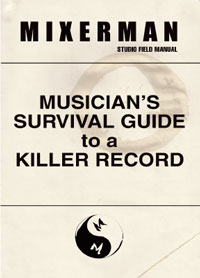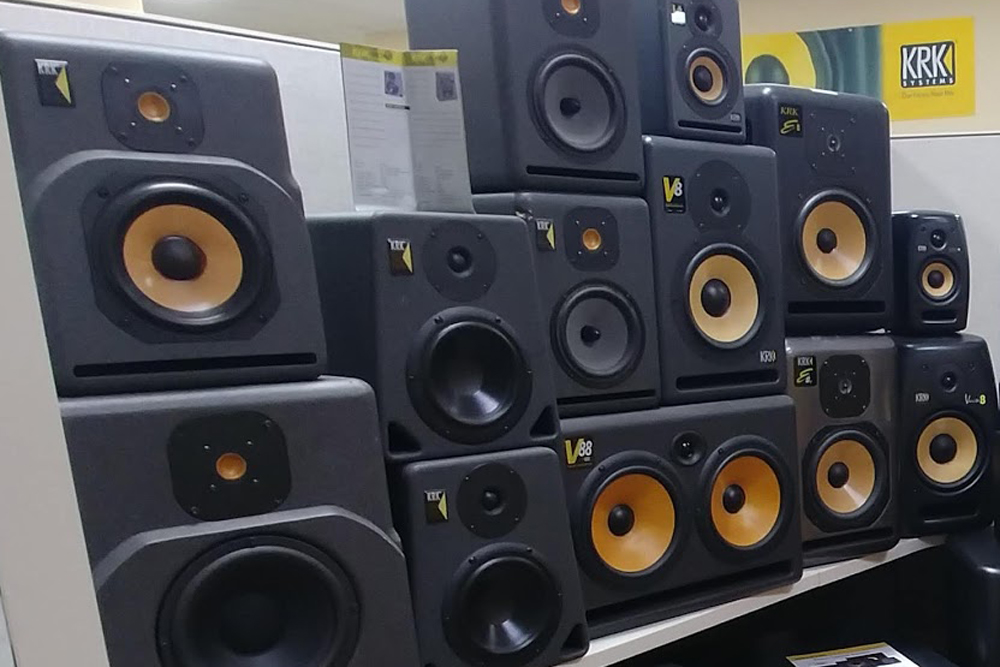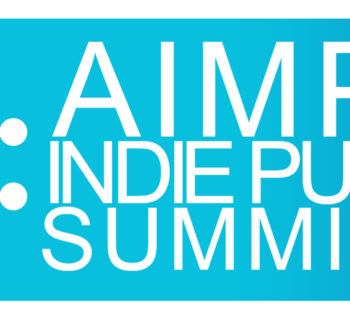The award-winning producer, mixer and recordist known as Mixerman has built a colorful, controversial reputation as an industry pro who’s not afraid to state his opinions about how–and how not–to make great records. The man knows how to get a reaction, okay? In the following article, based upon his new book Musician’s Survival Guide to a Killer Record, Mixerman delivers blunt, common sense insights and rock-solid encouragement to artists struggling to self-produce great recordings in their home studios.
It’s Grammy season once again, and that means it’s time for us to celebrate by recognizing the most popular songs and artists of the year. These are the works that we would have to go well out of our way to avoid. That doesn’t make them universally adored, mind you. There’s no such thing. It just makes them the most popular at the moment.
Regardless of what you or I might think of the current crop of popular music, the fact of the matter is, we’d all like our music to be in that position. That is to say the position of a hit. You see, a hit isn’t defined by genre or style, or even quality, for that matter. A hit is merely a song that has garnered a widespread reaction. Quality is subjective. A reaction is quantifiable.
I’ve been a part of a number of hits as a recordist, mixer and producer over the years, and while it’s all very exciting when a project you’ve worked on elicits a reaction, I can assure you that it doesn’t compare at all to what it’s like as the artist. I know. I’ve been fortunate enough to have gone through it.
You see, in late July of 2002 I began posting a surreptitious online journal as an anonymous recording engineer on a major label recording session with a bidding war band and an infamous producer. I called it “The Daily Adventures of Mixerman.”
Readers flocked to discussion boards like Pro Sound Web and The Velvet Rope to unpack the day’s events of my recording session turned reality blog. Some criticized me for breaking the sanctity of a private recording session. Others defended me for revealing the truth of it all. And everyone wondered openly whether the album would ever be completed, if only so that they might find out the who of it all. As it turns out, a small readership of 200 audio engineers quickly turned into a robust audience of 150,000 rabid fans from all corners of the music business. My story had gone viral before viral was even really a thing. Put simply, there was a reaction.
It doesn’t really matter that my first diary entry was originally written in the third person (since fixed), or that I had an affinity for backwards sentence construction, mixed metaphors, and the ending of sentences in prepositions. I was, generally speaking, a technically atrocious writer. Which is kind of funny, because despite the great strides I’ve made in that regard, I’m still attracted to the pure and inviting rawness of my prose from that time. I sometimes wish I could tap into that again, because despite any technical shortcomings as a writer, I did have some things going for me. I had a strong voice and something to say, which seems to be what attracted people to it. That’s what attracts people to any art.
Technology Drives Music
Things have changed dramatically since I wrote my “Daily Adventures.” The early aughts in music were years of unbridled success and the excess that goes along with it. The major labels were making record profits, mostly due to catalog sales along with the outrageous $17 price tag found on most commercial CDs. Distributors couldn’t make records fast enough, and really didn’t care how much it cost to make them. As a result, half-million dollar recording budgets were seemingly commonplace in Los Angeles.
This was also around the time that the DAW had made significant inroads as a popular tool for modern record productions. Every major recording studio had a full-blown $30,000 DAW sitting next to their $50,000 analog 2” machines, and every minor studio had finally chucked their ADATs so as to fully adopt the DAW. The powerful editing and tuning functions that were now available to us as record-makers had changed everything in terms of production trends. No longer was a major label constrained by the quality of a band’s musicianship. That could be fixed by a talented producer and her DAW. A group’s ability to play well was almost irrelevant. All that mattered was one undeniable song that could be taken to radio. Everything else was merely filler material. This is what happens when quarterly profits are deemed more important than the long-term development of artists.
Between the ease of sharing digital technology and the stunning greed exhibited by the major distributors at the time, young music consumers revolted by downloading music from illegal sharing sites like Napster. The freakout was real as the RIAA took to suing kids for serial copyright infringement. And by the time the industry had finally managed to shut Napster down, streaming sites like Pandora and Spotify had come to the fore. Now consumers could listen to music legally, without contracting a computer virus, and they could do so as often as they liked for free.
Not only do we have well over 50 years of music that’s still relevant––even to our youngest of fickle music fans––consumers have also had unbridled on-demand access to most of that music for well over a decade.
Music Has Value, How?
Yet somehow, if you ask random strangers how important music is to their life, most will put it up there with things like eating, sleeping and schtupping. For the large majority of us, music has value. We just don’t want to pay for it. That’s what happens when you get something for free for long enough.
Even if Google were to get their way and manage to figuratively drown copyright in a bathtub (and they’re trying), there will always be ways to capitalize on music. Even if all new songs were placed into the public domain, you could still make a living with music. Popular artists would be able to make a living off their notoriety alone. Which is precisely what tech companies like Google count on. It’s pretty much the business model of the Internet. A large corporation provides us with free space for our content. We all hope to get famous and capitalize.
As such, the days of a shitty, unknown band landing a major label deal out of their garage is over. Major labels don’t even pretend to act as a filter of good taste or the purveyors of trends. All they really care about are the numbers. How many social media fans have you acquired? How many people come to your shows? What is your current stream count? Whereas the major labels used to act as a filter for the consumer, the consumer now acts as a filter for the labels. That’s because the label cares about one thing and one thing only. A reaction. Why should they care about anything else?
Whereas the music fan had long transitioned to digital listening mediums, early aughts record producers were still operating primarily in the analog domain. Sure, the final product was a digital CD, which could be ripped to a digital file, but the process of making that CD was predominantly performed through analog equipment. Some viewed it as protectionism at its finest, since analog recording virtually required an expensive studio, a producer, a recording engineer, an assistant recording engineer and a DAW operator. That’s right, the DAW operator was a thing. Such are the benefits of excess and abundance. You can hire specialists and rent large purpose-built rooms full of fancy decades-old equipment to make your record for weeks on end. Fast-forward 15 years, and now, it doesn’t really matter whether you’re a home studio owner or a musician recording at home, one person does all of those jobs. You.
As I reflect on all of the debates over the years between audio professionals online, I can’t help but chuckle to myself. At times they got downright personal in nature. I still have an acoustician stalker who is so unhinged over my positions from nearly a decade ago that he still actively cultivates a Mixerman hate page. And although the general pervasiveness of ill-will toward our fellow music makers may not have changed much over the years, the nature of the arguments have. Whereas audio forums used to be a place for professional recordists, mixers and producers to debate the merits and implementation of recording technology, they are now the place where musicians go for misguided recording advice.
Why is it misguided? Because the needs of a musician recording herself at home are not the same as the needs of an engineer who is paid to record others. For instance, many engineers are of the belief that operating at a 96 kHz sample rate makes their life easier. Which is the reason one should choose any technology. Because it makes your life easier. But what about for those musicians working on a computer past its prime or, worse yet, on a decade old legacy system? Under either circumstance one would be hard pressed to run at higher sample rates.
I can assure you, the average music fan will never be the wiser as she streams a lossy MP3 through the lossy Bluetooth airwaves to a subwoofer masquerading as a boombox. Logic would dictate that the sample rate at which you record will have no bearing whatsoever, neither positively nor negatively, on the success of your record. None.
Then there are the home and DIY recording forums and groups, which have become nothing short of feedback loops of misinformation. For whatever reason, the culture of the home recording crowd is to eschew the advice of long-standing professionals such as myself. These kinds of forums have become nothing more than social clubs in which the goal is seemingly to make music with as little recording equipment as humanly possible. That’s kind of a weird goal.
 Your Creative Space
Your Creative Space
The problem with recording at home isn’t the equipment. At this point, we all have access to what amounts to a fully functional studio in a box, complete with sound library, MIDI functionality and soft synths. Anyone can put together a powerfully creative music production system with nothing more than a computer, an interface (with mic preamps), some monitors, and a mic. That’s really all the equipment that you need to make a record. The problem is, you also need a room that you can hear in.
Even a cursory search on the Internet will reveal the truth of the matter: if you can’t accurately hear what’s coming from your monitors in a way that translates outside of your space, then you are performing the metaphorical equivalent of painting color blind. And while every control room on earth is flawed in some way, there are certain sonic anomalies that cannot be overcome regardless of ego or perseverance. Without an investment in some significant acoustic treatments, you will spend your days comparing what you hear in your room to what you hear outside of your room, and you will frustrate yourself endlessly in the process. Cue up the headphones.
Of course, if you post a question on an engineering board about mixing with headphones, the response will be to never use headphones! And if you post a question about mixing with headphones on a home recording forum, you’ll likely get a long list of inexpensive headphones, with nary a warning about making balance decisions on a closed-ear system. And while it’s true that headphones aren’t the ideal critical listening environment, if what you’re hearing in your room doesn’t even remotely translate to the outside world, or worse yet, if your mate is asleep in the bed behind you, headphones would seem the most logical solution.
Then there’s the space where you record. Sound travels within your recording space and reacts with it. As such, the microphone picks up that information, even one that is placed in close proximity to the instrument. The space is literally half the capture, and if you don’t have the appropriate space for your vision, then you will be disappointed with the results. You’re not going to get big Led Zeppelinish drums in a small, untreated bedroom. None of that can be used as an excuse.
You can’t just slap a disclaimer onto your record telling would-be fans that your room is shit, and that’s why your record doesn’t sound good. Besides, that’s not the actual problem. It’s not that your record doesn’t sound good. It’s that your record didn’t come out as you intended because you chose not to fix a critical problem, but rather to offer it up as an excuse.
The moment you start to introduce excuses for your record is the moment it can no longer be considered art. At that point, it’s merely a demo. What’s the difference between a record and a demo? The record causes a reaction. And on those occasions when you find you can’t seem to beat the demo, it’s likely because you’re trying to improve the sound when it’s the feeling that you’re chasing. If the demo feels right, then the demo is the record regardless of how or where it was recorded.
That said, as effective as recording at home can be, you would do well to accept that you’re operating within limitations. This should be nothing new. Music has limitations. Our skill set has limitations. Our musicianship has limitations. We manifest our creativity in how we operate within those limitations. Otherwise, only the greatest musicians would have hit records. And if sound really mattered, only the greatest engineers would have hit records. Neither of those are even remotely close to true.
So, if the success of a record isn’t about musicianship or virtuosity of instrument, and if it’s not about sound, then what is it about? Marketing? Promotion? Certainly, getting the word out is a vital part of people finding your art. The trick is to build your fanbase to such a mass that by the time you manage to create something undeniable your base is there to spread the word for you. And while we should all hope that our first works of art cause an enormous viral reaction by strangers, that is the more unlikely path. As such, your relationship with your most devout patrons becomes essential to your success. You’re going to need them down the line.
We’re All Content Creators Now
All of this is true for anyone who creates content, and as far as I can tell, that’s pretty much everyone now. Even engineers and producers are content creators. It’s to the point that anyone who has made a record of note is virtually a public figure in what amounts to a circuit of content creators for the content creators themselves. There are literally hundreds if not thousands of recording tutorial makers and music production book writers offering their self-help products, many for free by people who have been recording for only a minute themselves. Encouragement is not advice, nor is it experience. Not that it matters. The product isn’t produced for purposes of education. That’s the guise. It’s purely about entertainment.
Is it any wonder that our current President of the United States is a former reality television star who is exceptionally skilled at provoking a reaction? Is it an accident that cable news presents complex policy issues of deep nuance as a stark choice between two overly-simplified directly competing positions? Cable news isn’t about disseminating information. It’s about fanning the flames of a reaction.
When you think about it, there really is no delineation between a record, a TV show, a movie, a magazine, a blog, a book, a news story, an instructional video or even a social media post for that matter. They are all methods of communication competing for our attention.
Where it comes to a record, it’s the song that people adore. It’s the performance of the song that connects the listener to the artist. And it’s the arrangement of the song that causes the physical reaction to it.
Singing is a physical reaction. Dancing is a physical reaction.
If you get the song, the performance and the arrangement right, then you will cause yourself to react. If you can cause yourself to react, then you will cause others to react in a similar manner. At that point, it’s merely a matter of finding your audience.
Strike A Chord
As difficult as the technological transitions in music and life have been in recent decades, we have much to be optimistic about moving forward. After putting out my first five books with a large publisher, I chose to publish my latest book––Musician’s Survival Guide to a Killer Record––myself. And while there are certain advantages to working with a publisher, distribution is no longer one of them. Between Amazon and other Print-On-Demand vendors, I can deliver a high-quality product anywhere in the world. So, if distribution isn’t an issue, then so long as I make a product that hits the mark with my fanbase (and beyond), then it should be successful. Not because I had the best printing. Not because I had the best cover design. Not because I had a big company behind my product. Not because I got scared and gave it away for free. It will succeed because the content strikes a chord. Because what I had to say, and how I had to say it got a reaction.
Forget about the endless procession of inconsequential things that all seem so important at the time. Art is whim. When you place too much of your focus and attention on the process, you risk missing out on the art itself.
Whereas technological changes have wreaked havoc on our industry, they have also opened up opportunities for those of us who are compelled to independently produce our music. It’s just that now we are all competing against millions of other content creators with precisely the same access to distribution regardless of the medium. As such, it’s more important than ever that we all understand the goal.
Where it comes to your art
Whether a song, a story, or an errant brain fart
The best way I know to gain some traction?
Go out of your way to seek a reaction.
My friends, it’s all about the reaction.
Congratulations to this year’s Grammy winners.
– Mixerman
 ERIC SARAFIN AKA MIXERMAN is a Gold and Multiplatinum award-winning producer, mixer and recordist who has made records with The Pharcyde, Tone Loc, Spearhead, The Brand New Heavies, Ben Harper, Amy Grant, Lifehouse, Barenaked Ladies, Hilary Duff, Foreigner and Australian phenom Pete Murray, just to name a few. Mixerman is also a popular author with two satires, The Daily Adventures of Mixerman and #Mixerman and the Billionheir Apparent, along with his how-to philosophy books on the recording arts, Zen and the Art of Mixing, Zen and the Art of Producing and Zen and the Art of Recording. His latest book, Musician’s Survival Guide to a Killer Record, is available at Amazon and directly addresses the needs of musicians who seek to improve their own recordings without thinking like an engineer in the process. Visit Mixerman.net, twitter.com/mixerman, facebook.com/mixerman, facebook.com/groups/mixermania, iinstagram.com/hashtag_mixerman, youtube.com/c/MixermanEricSarafin. To join Mixerman’s mailing list: mixerman.net/list
ERIC SARAFIN AKA MIXERMAN is a Gold and Multiplatinum award-winning producer, mixer and recordist who has made records with The Pharcyde, Tone Loc, Spearhead, The Brand New Heavies, Ben Harper, Amy Grant, Lifehouse, Barenaked Ladies, Hilary Duff, Foreigner and Australian phenom Pete Murray, just to name a few. Mixerman is also a popular author with two satires, The Daily Adventures of Mixerman and #Mixerman and the Billionheir Apparent, along with his how-to philosophy books on the recording arts, Zen and the Art of Mixing, Zen and the Art of Producing and Zen and the Art of Recording. His latest book, Musician’s Survival Guide to a Killer Record, is available at Amazon and directly addresses the needs of musicians who seek to improve their own recordings without thinking like an engineer in the process. Visit Mixerman.net, twitter.com/mixerman, facebook.com/mixerman, facebook.com/groups/mixermania, iinstagram.com/hashtag_mixerman, youtube.com/c/MixermanEricSarafin. To join Mixerman’s mailing list: mixerman.net/list













